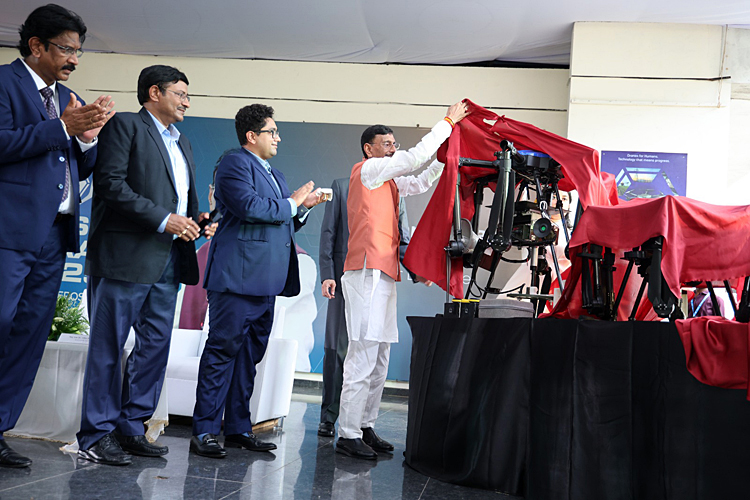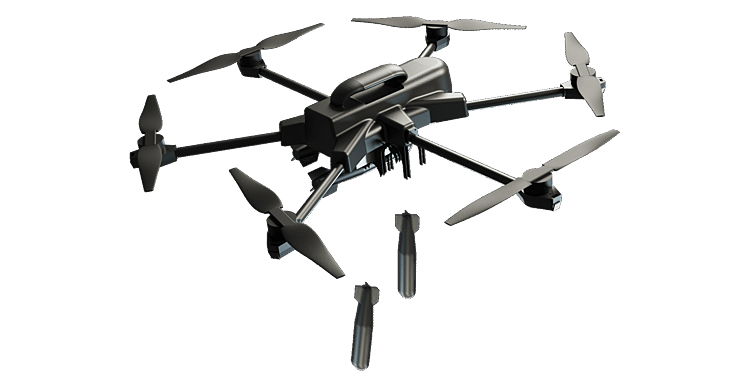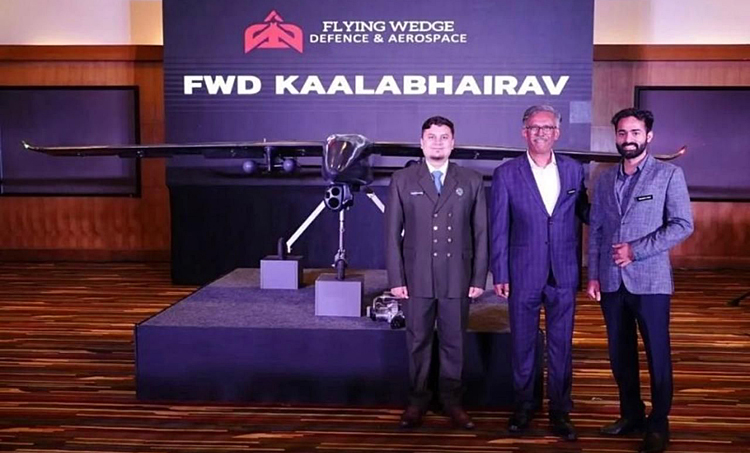INDIAN ARMED FORCES CHIEFS ON OUR RELENTLESS AND FOCUSED PUBLISHING EFFORTS

The insightful articles, inspiring narrations and analytical perspectives presented by the Editorial Team, establish an alluring connect with the reader. My compliments and best wishes to SP Guide Publications.

"Over the past 60 years, the growth of SP Guide Publications has mirrored the rising stature of Indian Navy. Its well-researched and informative magazines on Defence and Aerospace sector have served to shape an educated opinion of our military personnel, policy makers and the public alike. I wish SP's Publication team continued success, fair winds and following seas in all future endeavour!"

Since, its inception in 1964, SP Guide Publications has consistently demonstrated commitment to high-quality journalism in the aerospace and defence sectors, earning a well-deserved reputation as Asia's largest media house in this domain. I wish SP Guide Publications continued success in its pursuit of excellence.
- Appointments Committee of Cabinet approves one-month extension in service of Chief of the Army Staff
- Prime Minister witnesses 'Bharat Shakti' – a Tri-Services Firing and Manoeuvre Exercise in Pokhran, Rajasthan
- Interim Defence Budget 2024-25 — An Analysis
- Union Defence budget 2024
- Indian Army: In quest of greater firepower and policy recommendations for gaps
- Indian Army Annual Press Conference 2024
- Tata Boeing Aerospace Delivers 250 AH-64 Apache Fuselages, Manufactured in India
Specialised UAVs & Kaala Bhairav Drone
From AI-powered combat UAVs and stealth platforms to dedicated defence parks and export deals, India is rapidly building a self-reliant and globally competitive drone industry
 |
The Author is Former Director General of Information Systems and A Special Forces Veteran, Indian Army |

Indigenous drone technology is growing rapidly in India both in the public and private sector, together with a burgeoning startup ecosystem, focused on AI-powered combat drones like Kaala Bhairav, Medium-Altitude Long-Endurance (MALE) drones such as the Drishti 10 Starliner, and stealth UCAVs like the Ghatak. Systems are being developed for surveillance, precision strikes, and counter-drone capabilities. The Kaala Bhairav drone has a 3,000 km range and endurance of 30 hours. The Drishti 10 Starliner is India's first indigenous MALE UAV, while Rustom of the Defence Research and Development Organisation (DRDO) is also in the same category. The Ghatak is a stealthy, autonomous, jet-powered UCAV capable of carrying precision-guided munitions. India is also developing kamikaze drones for tactical missions, as well as anti-drone systems capable of detection, jamming (soft kill), and laser-based destruction (hard kill) of attacking drones.
Garuda Aerospace said that the company's mission is to make India self-reliant in defence drone technology, aiming by 2027 to set global standards in innovation and reliability
Many indigenous drones are designed for autonomous navigation and route planning, including the ability to return to base autonomously if communication is lost. Concurrently, some designs, like the Rudrastra, combine vertical take-off and landing (VTOL) with fixed-wing capabilities for versatile flight. Drones are being equipped with capabilities such as air-burst technology for targeting enemy camps and bunkers. The focus on artificial intelligence (AI) integration allows for highly intelligent drones with features like on-board mission computers and autonomous decision-making.

According to news reports of August 23, 2025, Garuda Aerospace inaugurated its Defence Drone Facility in Thalambur, Chennai on August 22, 2025, which was attended by Union Minister of State (MoS) for Defence Sanjay Seth. Garuda Aerospace unveiled five advanced unmanned aerial vehicles (UAVs) at the event, each designed for specific military and rescue missions. These include the 'Avalanche Victim Drone' for high-altitude rescue operations, the 'Swarm Drone' for coordinated strikes and surveillance, the 'Jawan Drone' for frontline soldier support and tactical use, the 'Canister Dropping Drone' for rapid payload delivery in battlefields, and 'Droni 2.0', an upgraded multi-purpose drone platform for defence and civilian applications.

In addition to the launch of the above drones, Garuda Aerospace introduced multiple initiatives such as the Defence Drone Lab developed in partnership with the 13 JAK Rifles from Ladakh and Gwalior to foster mission-specific innovation within the Indian Armed Forces.The company also rolled out a Free Remote Pilot Certification programme to train Indian defence personnel, with the first batch of soldiers certified during the inauguration. Garuda Aerospace Founder and CEO Agnishwar Jayaprakash said that the company's mission is to make India self-reliant in defence drone technology, aiming by 2027 to set global standards in innovation and reliability.
Concurrently, the foundation stone was laid for a 76-acre Defence Park in Cheyyur, Tamil Nadu, along the East Coast Road. This facility is planned to be India's most advanced indigenous hub for AI-powered, precision weaponised drones, encompassing research, manufacturing, and testing capabilities to bolster India's defence ecosystem. The MoS Sanjay Seth highlighted that this facility represents a comprehensive ecosystem integrating design, R&D, incubation, certification, and production, facilitated by collaboration between academia, industry, and defence sectors.
Bengaluru-based defence start-up 'Flying Wedge Defence and Aerospace (FWDA)' has unveiled its 'Kaala Bhairav' combat drone, with an endurance of 30 hours and a strike range of up to 3,000 km, comparable to the American MQ-9 Reaper but can operate at just a tenth of the Reaper's cost
The event marked a significant step towards strengthening India's defence and disaster response capabilities, aligning with the government's Atmanirbhar Bharat vision of self-reliance. The launch of these five specialised drones and the associated ecosystem initiatives represent a major milestone in boosting India's battlefield and rescue capabilities through indigenous innovation and technological self-reliance.
Simultaneously, the Bengaluru-based defence start-up 'Flying Wedge Defence and Aerospace (FWDA)' has unveiled its 'Kaala Bhairav' combat drone, positioned as the country's first fully indigenous Medium Altitude Long Endurance (MALE) autonomous combat UAV, marking an important step in India's broader agenda of self-reliance in defence technology under the Atmanirbhar Bharat initiative. The announcement coincides with the company's success in securing a $30 million export order from an undisclosed South Asian nation, an early but critical validation of FWDA's capability on the international stage.

The Kaala Bhairav platform has been designed with strategic autonomy at its core, reflecting India's unease over continued reliance on foreign-origin defence systems such as the American MQ-9 Predator drones and Israeli Searcher models. Imported systems often come with embedded vulnerabilities, such as potential kill-switch mechanisms and the risk of sensitive flight data being routed through external servers, thus raising espionage and operational security risks. Moreover, tightening US export controls on advanced military technologies exemplifies that dependence on foreign suppliers could hinder India's wartime flexibility. Against this backdrop, the Kaala Bhairav project embodies a strategic attempt to create an independent ecosystem shielded from supply chain disruptions and sanctions.
The Kaala Bhairav drone incorporates swarm warfare capabilities, enabling coordinated autonomous operations where multiple drones can overwhelm sophisticated air defence systems through multi-angle, precision strikes
The Kaala Bhairav with an endurance of 30 hours and a strike range of up to 3,000 km is comparable to the American MQ-9 Reaper but can operate at just a tenth of the Reaper's cost according to the FWDA. The company highlights that where the loss of a Predator drone could amount to financial damages of nearly ₹1,000 crore, the same investment could instead field an entire fleet of Kaala Bhairav platforms.
The Kaala Bhairav drone incorporates swarm warfare capabilities, enabling coordinated autonomous operations where multiple drones can overwhelm sophisticated air defence systems through multi-angle, precision strikes. Also, the platform has been built with complete indigenous sourcing of components and localised manufacturing of maintenance, repair, and overhaul (MRO) infrastructure, ensuring a sanctions-proof, self-sustaining ecosystem. By eliminating dependence on foreign Original Equipment Manufacturers (OEMs) for spare parts or technical expertise, FWDA is attempting to deliver faster turnaround times, reduced lifecycle costs, and uninterrupted operational support; capabilities that are essential for active deployment.
Kaala Bhairav now must demonstrate not only its combat effectiveness but also operational reliability, regulatory compliance with international arms trade protocols, and after-sales support. The signing of the initial $30 million export agreement with a South Asian client provides FWDA with a critical opportunity to establish credibility in terms of real-world usage, mission reliability, and customer satisfaction. The rise of Flying Wedge Defence as a credible private player reflects the government's Defence Production Policy of 2020, which emphasises the integration of the private sector in high-end indigenous technology development. Kaala Bhairav marks a significant advance in India's aerospace sector, with the potential to boost exports.





